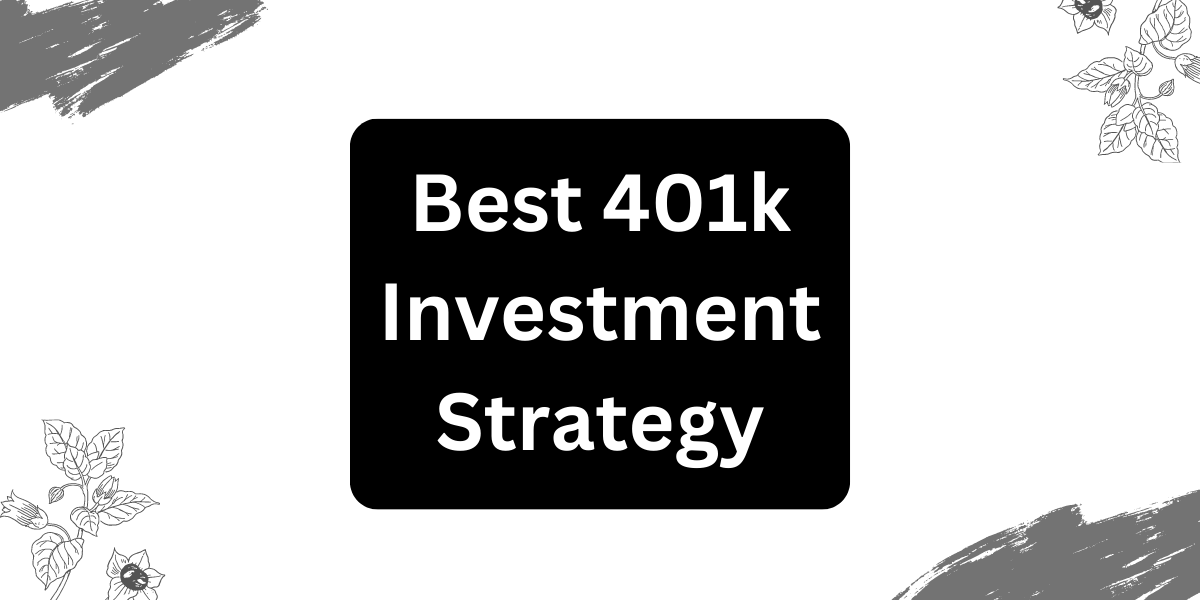This article will provide readers with a comprehensive understanding of the best 401k investment strategy, serving as a blueprint for retirement success. It aims to guide individuals in making informed decisions about their 401k investments, ensuring they optimize their savings and achieve their desired financial goals in retirement.
Securing a comfortable and financially stable retirement is a goal that many individuals strive for. As the traditional pension system wanes in popularity, 401k plans have become a vital tool for individuals to build their retirement nest egg. However, simply participating in a plan is not enough. To truly optimize your savings and set yourself up for a prosperous retirement, you need a good 401k investment strategy.
In this article, we will explore the intricacies of a investment strategy and will cover all aspects necessary to unlock the full potential of your 401k.
Whether you are just starting your career or are approaching retirement age, this article is designed to help you make the most of your 401k plan.
Let’s unlock the blueprint for retirement success by mastering the solid 401k investment strategy.
What is 401k investment strategy?
A 401k investment strategy refers to a plan of action designed to optimize the growth and performance of your 401k retirement savings. It involves making informed decisions about how you allocate your contributions within the available investment options in your 401k plan.
A well-crafted investment strategy takes into account factors such as your risk tolerance, financial goals, time horizon until retirement, and market conditions. It aims to maximize returns while managing risk effectively.
Key components of a strategy include asset allocation, diversification, and regular monitoring and adjustments.
It is important to note that a best investment strategy should be tailored to your individual circumstances and goals. Factors such as age, retirement timeline, risk tolerance, and financial situation will influence the specific strategy that is right for you.
Types of 401k Investments
When it comes to 401k investments, understanding the different types available is key to building a successful retirement portfolio. A well-diversified portfolio can help mitigate risk and maximize returns over the long term.
In this section, we will explore the various investment options within a 401k plan, providing insights into their characteristics, benefits, and considerations. By familiarizing yourself with these investment types, you can make informed decisions and tailor your portfolio to align with your risk tolerance and financial goals.
Stocks
Stocks, also known as equities, represent ownership shares in a company. Investing in stocks lets you participate in the company’s growth and profit potential. Stocks can range from large, established companies to smaller, emerging businesses. They offer the potential for higher returns but also come with increased volatility. Understanding different types of stocks, such as blue-chip stocks, growth stocks, and dividend stocks, can help you construct a well-rounded stock portfolio within your 401k.
Bonds
Bonds are fixed-income securities where investors lend money to corporations or governments in exchange for regular interest payments and the return of the principal at maturity. Bonds are generally considered lower-risk investments compared to stocks. They offer stable income and can provide a buffer against stock market volatility. Within bonds, you may encounter various types, such as government bonds, corporate bonds, municipal bonds, and Treasury bonds. Each type has its risk profile and potential returns.
Mutual Funds
Mutual funds pool money from multiple investors to invest in a diversified portfolio of stocks, bonds, or other assets. They are managed by professional fund managers, making them suitable for investors seeking instant diversification without the need for individual security selection. Mutual funds offer a range of investment strategies, including index funds, actively managed funds, and target-date funds. They can provide exposure to various market sectors, asset classes, and investment styles.
Target-Date Funds
Target-date funds (TDFs) are a popular choice for 401k investors. These funds automatically adjust their asset allocation based on the target retirement year specified by the investor. TDFs start with a more aggressive investment approach when retirement is far away, gradually transitioning to a more conservative strategy as the target date approaches. They simplify the investment process and provide a convenient option for investors who prefer a hands-off approach.
Other Investment Options
In addition to stocks, bonds, mutual funds, and target-date funds, your 401k plan may offer other investment options. These can include exchange-traded funds (ETFs), real estate investment trusts (REITs), money market funds, and stable value funds. Understanding the characteristics, risks, and potential returns of these options can help you diversify your portfolio further and optimize your 401k investments.
Crafting Your Best 401k Investment Strategy
Crafting a well-thought-out best 401k investment strategy is key to maximizing returns and managing risk in your 401k. A strategic approach ensures that your portfolio aligns with your financial goals, risk tolerance, and investment horizon.
In this section, we will explore the essential elements of crafting an effective 401k investment strategy. From diversification and asset allocation to rebalancing and staying informed, you will gain insights and strategies to optimize your 401k investments.
Diversification and Asset Allocation
Diversification is a cornerstone of a successful investment strategy. It involves spreading your investments across different asset classes, such as stocks, bonds, and cash equivalents. This helps reduce the impact of any single investment on your portfolio’s performance.
Asset allocation refers to determining the percentage of your portfolio allocated to each asset class based on your risk tolerance and financial goals. Understanding the importance of diversification and asset allocation and implementing them within your 401k can help manage risk and enhance long-term returns.
Balancing Risk Tolerance and Investment Horizon
Your risk tolerance and investment horizon play vital roles in crafting your strategy. Risk tolerance refers to your ability to withstand fluctuations in investment values. It’s important to align your portfolio’s risk level with your comfort level. Additionally, your investment horizon, or the time until you need to access your funds, affects your strategy. Longer investment horizons may allow for greater exposure to growth-oriented investments, while shorter horizons may warrant a more conservative approach. Striking the right balance between risk tolerance and investment horizon is crucial in optimizing your returns.
Strategies for Managing and Rebalancing Your Portfolio
Regularly reviewing and rebalancing your portfolio is essential to maintain its intended asset allocation. Rebalancing involves adjusting your portfolio’s holdings back to their original targets. This ensures that your investments stay in line with your desired risk-return profile. Implementing strategies such as calendar-based rebalancing or threshold-based rebalancing can help you stay on track. Additionally, monitoring your investments and making informed adjustments based on market conditions and changes in your financial situation is vital for long-term success.
Staying Informed and Educated
Keeping yourself updated and well-informed about market trends, economic indicators, and investment strategies is crucial. Stay abreast of financial news, read reputable sources, and consider seeking professional advice when needed. Understanding the factors that influence your investments and staying educated about investment concepts can help you make informed decisions and adjust your strategy accordingly.
Regular Review and Evaluation
Regularly reviewing your investment performance is important for assessing the effectiveness of your strategy. Monitor the progress of your investments, track returns, and compare them against relevant benchmarks. Evaluate whether your investments are meeting your expectations and if any adjustments are necessary. Regular review and evaluation allow you to make data-driven decisions and make the necessary changes to stay on track towards your financial goals.
Evaluating and Adjusting Your Best 401K Investment Strategy
An effective 401k investment strategy requires regular evaluation and adjustments to ensure it remains aligned with your financial goals and market conditions. In this section, we will explore the importance of evaluating your strategy, identifying signs for adjustment, and implementing necessary changes. By staying proactive and responsive, you can optimize your 401k investments and maximize your chances of achieving retirement success.
Regular Review of Investment Performance
Regularly reviewing your investment performance is crucial for evaluating the effectiveness of your strategy. Monitor the performance of your individual investments and assess their contributions to your overall portfolio. Compare your returns against relevant benchmarks to gain insights into how your investments are performing. Identify areas of strength and areas that may require improvement.
Identifying Signs for Adjustment
Certain signs indicate that adjustments to your strategy may be necessary. These signs include:
A) Life Changes: Major life events, such as marriage, having children, or nearing retirement, may necessitate a reassessment of your investment strategy. Adjustments may be needed to accommodate new financial goals and time horizons.
B) Market Conditions: Changes in economic conditions or shifts in market trends may impact your investments. Stay informed about market developments and evaluate if adjustments are needed to capitalize on opportunities or mitigate risks.
C) Performance Discrepancies: If specific investments consistently underperform or deviate significantly from your expectations, it may be time to reevaluate their inclusion in your portfolio.
D) Risk Tolerance: Changes in your risk tolerance, whether due to personal circumstances or evolving financial goals, may warrant adjustments to your asset allocation and investment choices.
Rebalancing Your Portfolio
Rebalancing involves realigning your portfolio to its target asset allocation. Regularly rebalancing helps maintain your desired risk-return profile. When certain investments outperform others, their proportion in your portfolio may exceed your intended allocation. By selling a portion of these investments and reallocating the proceeds to underperforming assets, you can bring your portfolio back in line with your desired allocation.
Seeking Professional Guidance
If you feel overwhelmed or lack the expertise to evaluate and adjust your 401k investment strategy, consider seeking professional guidance. A financial advisor can provide valuable insights, help you navigate complex investment decisions, and offer personalized recommendations based on your specific needs and goals.
The Importance of Patience and Discipline
While evaluating and adjusting your strategy is crucial, it is equally important to exercise patience and discipline. Avoid making knee-jerk reactions based on short-term market fluctuations. Stay focused on your long-term goals and maintain a disciplined approach to your investment strategy.
Long-Term Growth and Compounding
When it comes to long-term investing in your 401k, the concepts of growth and compounding play a vital role. By understanding how time and compounding work together, you can leverage these powerful forces to maximize your wealth accumulation. In this section, we will explore the importance of long-term growth and compounding in your 401k investments, providing insights and strategies to set yourself up for financial success.
The Power of Compounding
Compounding is the process by which your investment returns generate additional earnings, which are then reinvested to generate more returns. Over time, the power of compounding can lead to exponential growth in your investments. By reinvesting dividends and capital gains, you can take advantage of compounding’s compounding effect. The earlier you start investing and the longer you stay invested, the more time compounding has to work its magic.
Time-Tested Best 401k Investment Strategies for Maximizing Growth
To maximize growth in your 401k, consider the following strategies:
Start Early: 1 (Best 401k Investment Strategy)
Time is one of the most valuable assets when it comes to investing. The earlier you start contributing to your 401k, the more time your investments have to grow.
Consistent Contributions: 2 (Best 401k Investment Strategy)
Regularly contributing to your 401k, even in smaller amounts, can make a significant difference over the long term. Consistency allows you to benefit from dollar-cost averaging and take advantage of market fluctuations.
Reinvest Dividends: 3 (Best 401k Investment Strategy)
Rather than cashing out dividends, reinvest them back into your 401k. Reinvesting dividends allows you to purchase more shares, which can lead to greater growth over time.
Take a Long-Term View: 4 (Best 401k Investment Strategy)
Avoid getting swayed by short-term market fluctuations. Adopting a long-term view helps you stay focused on your investment goals and ride out market volatility
Review and Adjust: 5 (Best 401k Investment Strategy)
Regularly review your investment performance and asset allocation. Consider rebalancing your portfolio periodically to maintain your desired risk-return profile.
Market Volatility: Strategies for Steadfast Investing in Turbulent Times
Market volatility is an inherent part of investing. Understanding how to navigate turbulent market conditions is crucial for maintaining a steady course towards your retirement goals. In this section, we will explore strategies to help you navigate market volatility and make informed decisions during uncertain times. By staying disciplined, avoiding emotional reactions, and capitalizing on opportunities, you can navigate market volatility with confidence.
Stay Disciplined and Focus on the Long Term
During periods of market volatility, it’s essential to stay disciplined and focus on your long-term investment goals. Avoid making impulsive decisions based on short-term market fluctuations. Stick to your investment strategy and maintain a diversified portfolio that aligns with your risk tolerance and financial goals. Remember that investing is a long-term endeavor, and trying to time the market can be detrimental to your returns.
Avoid Emotional Decision-Making
Emotions can cloud judgment and lead to irrational investment decisions. During market volatility, it’s crucial to detach yourself from emotional reactions. Avoid panic selling during market downturns or chasing after hot investments during market upswings. Instead, base your decisions on sound analysis and stay committed to your long-term investment plan.
Capitalize on Buying Opportunities
Market volatility can present buying opportunities for long-term investors. During market downturns, quality investments may become undervalued. Consider capitalizing on these opportunities by adding to your positions or initiating new investments at attractive prices. However, ensure thorough research and due diligence to identify investments with strong fundamentals and long-term growth potential.
Diversify and Rebalance Regularly
Maintaining a diversified portfolio can help mitigate the impact of market volatility. Spread your investments across different asset classes, sectors, and regions. Regularly rebalance your portfolio to realign your holdings with your target asset allocation. Rebalancing allows you to trim overperforming investments and add to underperforming ones, maintaining your desired risk-return profile.
Focus on Quality and Fundamentals
During periods of market volatility, it’s crucial to focus on quality investments with strong fundamentals. Look for companies with solid financials, competitive advantages, and proven track records. Fundamental analysis can help you identify investments with the potential to weather market volatility and deliver long-term growth.
Conclusion
In conclusion, the best 401k investment strategy is a crucial component of securing a successful retirement. By following the principles outlined in this article, you can unlock the path to financial freedom and retirement success.
Assessing your retirement goals provides a solid foundation for your strategy. Understanding your desired lifestyle, estimating expenses, and setting specific goals ensures your savings align with your aspirations.
Diversifying your investments across various asset classes, such as stocks, bonds, and mutual funds, mitigates risk and maximizes returns. A well-balanced portfolio tailored to your risk tolerance and investment horizon is key.
Harnessing the power of long-term growth and compounding is essential. Starting early, making consistent contributions, and reinvesting dividends allow your investments to grow exponentially over time.
Regularly evaluating and adjusting your strategy is necessary. Monitoring investment performance, identifying signs for adjustment, and rebalancing your portfolio maintain alignment with your goals and market conditions.
Navigating market volatility requires discipline and a long-term perspective. Avoiding emotional decisions, capitalizing on buying opportunities, and focusing on quality investments enhance your chances of success.
Remember, each individual’s financial situation is unique, so it’s essential to customize your strategy accordingly. Seek professional advice when needed and stay informed about market trends and economic indicators.
By implementing these strategies and staying committed to your 401k investment strategy, you can pave the way for a secure and fulfilling retirement. Start today, make informed decisions, and unlock the potential for long-term financial well-being.
Your retirement success depends on the actions you take today. With the best 401k investment strategy in place, you are on the path to a brighter financial future.
Disclaimer: The information for this written post has been taken from various sources on the internet. While we strive to provide accurate and reliable information, but cannot guarantee the accuracy or completeness of the information. Please use your discretion before making decisions or taking action based on that information. Therefore, any reliance you place on such information is strictly at your own risk.









